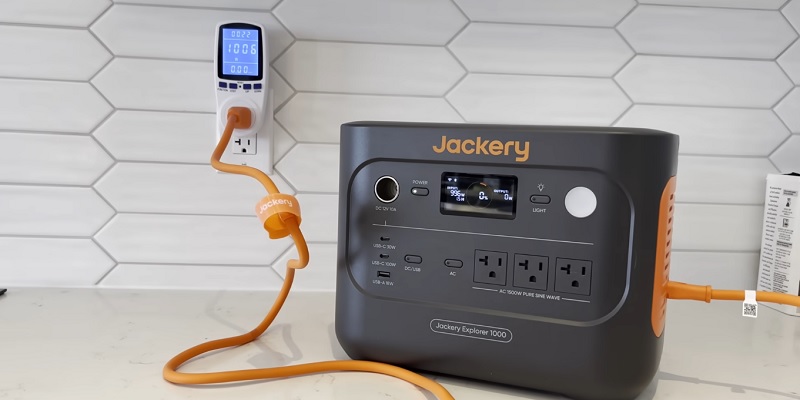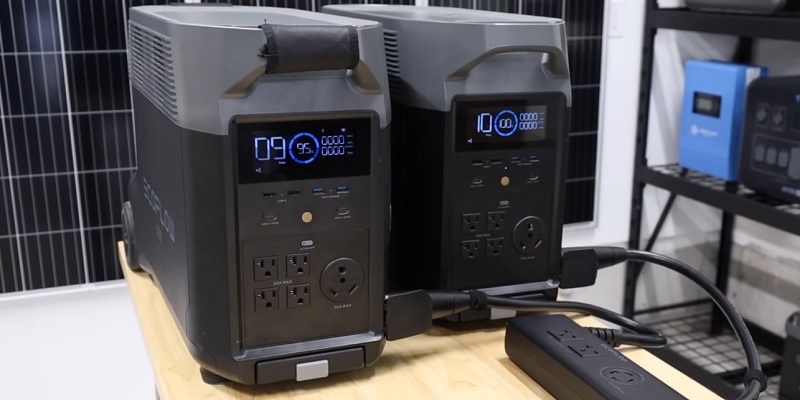Yes, you can overcharge a portable power station. Most modern devices have built-in safeguards to prevent this.
However, prolonged exposure to high voltage can still be harmful. Portable power stations have become essential for outdoor enthusiasts, travelers, and emergency preparedness. These compact devices store electricity for use on the go, powering gadgets and essential equipment. While they offer convenience, understanding their limitations is crucial.
Overcharging can reduce battery lifespan and efficiency. Knowing how to properly charge and maintain your power station can save you money and trouble. This blog will explore the risks of overcharging and provide tips to ensure your device stays in top shape. Learn how to protect your investment and keep it functioning optimally for years to come. Dive in to discover how to maximize your portable power station’s longevity and performance.

Portable Power Station Basics
Portable power stations are versatile tools for modern life. These devices offer convenient power solutions for outdoor adventures or emergencies. They are compact, easy to transport, and provide reliable energy.
Understanding their basic components and functions helps optimize usage. This knowledge ensures safe handling and enhances efficiency. Let’s explore the essentials of portable power stations.
What Is A Portable Power Station?
A portable power station is a rechargeable battery-powered generator. It supplies power without needing a wall outlet. They are essential for off-grid scenarios, camping, or power outages. These devices come with multiple output options for various electronics.
They typically include USB ports, AC outlets, and DC outputs. This allows them to power different devices simultaneously. They are quieter and more eco-friendly than traditional gas generators.
Key Components And Functions
Portable power stations have several core components. The most important is the battery, often lithium-ion for efficiency. The battery stores energy and provides power when needed.
Inverters are another critical part. They convert DC power from the battery to AC power. This conversion is necessary for most household electronics.
Charge controllers manage the charging process. They protect the battery from overcharging and extend its lifespan. Display screens show battery status and power usage.
Understanding these components helps users operate power stations safely. It ensures devices are connected properly and enhances energy management.
Charging Mechanisms
Understanding the charging mechanisms of portable power stations is crucial to ensure their longevity and optimal performance. These devices have revolutionized how we stay powered up on the go, but knowing how they charge can help you avoid mishaps like overcharging. While many of us are accustomed to plugging in our devices and walking away, there’s more to the story when it comes to portable power stations. Let’s dive into the various methods and safeguards that keep your power station charged efficiently and safely.
Types Of Charging Methods
Portable power stations offer flexibility with different charging methods, catering to various needs and situations. You can charge them using wall outlets, which is the most common and quickest method. It’s ideal for when you’re at home or in a place with reliable electricity.
Another option is solar charging, perfect for outdoor enthusiasts. Imagine you’re camping in a remote area; solar panels can keep your power station fueled without needing a grid connection. It takes longer but offers sustainable energy.
Car charging is also available, allowing you to charge your station while driving. It’s a lifesaver during road trips, ensuring your devices stay powered without stopping for a plug.
Role Of Built-in Regulators
Built-in regulators play a crucial role in preventing overcharging. These smart components monitor the charging process, cutting off the power supply once the battery is fully charged. This automatic feature protects your device from potential damage.
Think about your smartphone’s battery life. Excessive charging can degrade its capacity over time. Portable power stations with regulators work similarly, ensuring batteries last longer and perform better.
Have you ever left your laptop plugged in overnight, only to find it overheated in the morning? Built-in regulators in power stations prevent such scenarios by managing the power flow efficiently.
It’s worth checking if your portable power station has these safety features. They act as silent guardians, saving you from the hassle of battery replacement and ensuring your device remains reliable for years.
Do you trust the built-in systems of your gadgets, or do you prefer manually monitoring the charging process? Understanding these mechanisms can influence how you use and care for your power station.
Risks Of Overcharging
Portable power stations are handy for keeping devices charged on the go. But overcharging can lead to risks that users should be aware of. Understanding these dangers is crucial for maintaining the longevity and safety of your portable power station.
Potential Damage To The Battery
Overcharging can harm the battery in several ways. It may cause the battery to overheat, which can reduce its lifespan. Damage to the internal cells is another risk. This can lead to decreased performance. In some cases, the battery might not hold a charge as well.
Prolonged exposure to high voltage can also lead to swelling. This physical deformation is a sign of severe damage. It affects the battery’s ability to function properly. Repairing or replacing a damaged battery can be costly.
Safety Hazards And Precautions
Safety is a major concern with overcharging. An overheated battery can become a fire hazard. This poses a threat to both personal safety and property. In rare cases, a battery might explode due to extreme pressure build-up.
Taking precautions can prevent these dangers. Use a charger specifically designed for your power station. Avoid leaving the power station plugged in overnight. Regularly check for signs of overheating, like excessive warmth or strange odors. Following these steps can ensure safe and efficient use of your portable power station.
Preventing Overcharging
Portable power stations are lifesavers during power outages or adventures off the grid. However, overcharging can lead to reduced battery life or even safety hazards. Understanding how to prevent overcharging can maximize your power station’s performance and longevity.
Built-in Safety Features
Many portable power stations come equipped with built-in safety features. These features are designed to stop charging once the battery reaches full capacity. This means you can leave your device plugged in without constant monitoring.
Some models have an automatic shut-off feature, which kicks in when the battery is charged. Others have LED indicators that alert you when it’s time to unplug. Check your power station’s manual to discover the specific safety features it offers.
Best Practices For Charging
Adopting best practices for charging is crucial. Avoid charging your power station in extreme temperatures, as this can affect battery efficiency. Keep your device in a cool, dry place for optimal charging conditions.
Consider setting a timer as a precaution, even if your power station has built-in safety features. This ensures you’re not relying solely on technology to prevent overcharging. It’s a simple step that can save you from potential issues down the line.
Think about the times you’ve forgotten to unplug your phone charger. Did you notice any heat or wear on the device? Portable power stations are similar. Regularly check their temperature while charging to avoid overheating.
How often do you pay attention to the small details in your charging habits? Small adjustments can make a big difference in maintaining your power station’s health. Implementing these steps can enhance your device’s lifespan and reliability.
Impact On Battery Life
Portable power stations offer convenience for charging devices. But overcharging can harm battery life. Understanding these impacts is crucial for maintaining your power station. Let’s explore the effects of overcharging and ways to keep your battery healthy.
Extra 5% Off Coupon: 25EFBFAFF
Effects Of Overcharging On Longevity
Overcharging a battery leads to excess heat. This heat can degrade battery components over time. The battery may lose capacity, affecting its ability to hold a charge. Overcharging also stresses the battery, which can shorten its overall lifespan.
Repeated overcharging can cause irreversible damage. The battery may become less efficient and reliable. Users may notice a decrease in performance. Frequent overcharging can lead to more battery replacements. This can be costly and inconvenient.
Maintaining Optimal Performance
Proper charging habits ensure longer battery life. Disconnect the power station once fully charged. Use a charger designed for your specific model. Regularly check the battery’s condition and performance.
Store the power station in a cool place. Avoid exposing it to extreme temperatures. Follow manufacturer guidelines for charging and maintenance. Keep the battery clean and free from dust. This helps maintain optimal performance.
Monitor charging times closely. Do not leave the power station plugged in overnight. Use smart chargers to prevent overcharging. These steps protect the battery and enhance its durability.
Technological Innovations
The rise in demand for portable power stations has sparked significant technological innovations. These innovations aim to enhance the efficiency and safety of charging devices. One of the main concerns for users is the possibility of overcharging their power stations. Thankfully, recent technological advancements address this issue effectively.
Advancements In Battery Technology
Battery technology has come a long way. Modern portable power stations use lithium-ion or lithium-polymer batteries, which are more efficient and reliable. These batteries have built-in protection mechanisms that prevent overcharging.
Imagine the convenience of plugging in your power station overnight without worry. It’s all thanks to these advancements. They ensure your device stops charging once it reaches full capacity.
Smart Charging Solutions
Smart charging solutions are another breakthrough in this field. These solutions use advanced algorithms to monitor the charging process. They adjust the power input to prevent overcharging and extend battery life.
Next time you charge your power station, notice how it might slow down as it nears full charge. That’s smart technology at work. Such innovations not only protect your device but also optimize its performance.
Have you ever thought about how these technologies affect your everyday life? They make it easier and safer to use portable power stations. This means less hassle and more time enjoying your devices.
What other smart features have you noticed in your gadgets? Share your experiences and see how these innovations are shaping our interactions with technology. Your insights could help others make informed decisions.
User Tips
Portable power stations are a lifesaver when you need to keep devices charged on the go. However, using them properly is crucial to maintain their efficiency and longevity. Overcharging is a common concern, and understanding how to prevent it is key. Here are some user tips to help you ensure your portable power station is always ready and safe to use.
Signs Your Device Is Overcharging
Have you noticed your power station getting unusually hot? This might be a sign of overcharging. Heat is often the first indicator that something is amiss.
Another sign is if the battery drains faster than usual after charging. This could be due to damage caused by overcharging.
Pay attention to charging times. If it takes longer than expected or doesn’t seem to fully charge, it might be overcharging.
Steps To Take If Overcharging Occurs
First, stop charging immediately. Disconnect your power station from any power source.
Let it cool down. Give it some time before attempting to charge again, ensuring it’s at a safe temperature.
Check the manufacturer’s guidelines. They often provide troubleshooting steps specific to your model.
Consider investing in a smart charger. This can automatically stop charging once your device is full, minimizing the risk of overcharging.
Extra 5% Off Coupon: 25EFBFAFF
Remember, staying informed and cautious can prolong the life of your portable power station. How often do you check yours for signs of overcharging?
Choosing The Right Power Station
Choosing the right portable power station ensures safety and efficiency. With many options available, finding the best match for your needs can be challenging. Consider important features and compare various models to make an informed decision.
Features To Look For
Look for a power station with a high battery capacity. This ensures longer use. Check the number of output ports. More ports allow you to charge multiple devices. Ensure the power station has fast charging capabilities. This saves time and keeps your devices ready. Look for safety features. These include overcharge protection and temperature control.
Comparing Models And Brands
Research different models and brands before buying. Compare battery capacities among various options. Some models offer solar charging capabilities. This is ideal for outdoor use. Check user reviews for reliability and customer satisfaction. Look at the warranty offered by the brand. A longer warranty indicates a reliable product. Finally, consider the weight and size of the power station. Portable designs are easier to carry.
See Here: Best Portable Power Stations for Home Backup
Frequently Asked Questions
Can You Leave A Portable Power Station Plugged In All The Time?
You can leave a portable power station plugged in, but it’s not always recommended. Check the manufacturer’s instructions. Continuous charging can reduce battery lifespan. Use a smart charger if available to prevent overcharging. Regularly monitor the device for safety and efficiency.
What Happens If You Overcharge A Portable Charger?
Overcharging a portable charger can reduce its lifespan and efficiency. It may cause overheating, which risks damage or fire. Always use a charger with built-in overcharge protection to prevent these issues. Monitor charging times and disconnect once fully charged to ensure safety and prolong battery life.
Can You Over Charge A Jackery?
Jackery devices have built-in protection to prevent overcharging. Once fully charged, they stop drawing power automatically. Always use the recommended charger to ensure safety and optimal performance. Regularly check for software updates to maintain proper functioning and avoid charging issues.
How Long Does A Portable Power Station Stay Charged?
The charge duration of a portable power station varies by model. Typically, it stays charged for 3 to 6 months. Factors like battery capacity and usage patterns influence this timeframe. Regularly check and recharge every few months to maintain optimal performance.

Final Thoughts
Avoid overcharging your portable power station. It helps extend its lifespan. Proper care ensures efficiency and safety. Follow the manufacturer’s guidelines. Use the right charger. Monitor charging times closely. These steps prevent damage and maintain performance. A well-maintained power station is reliable.
It serves you well in emergencies. Regular check-ups are wise. Keep your power station in good shape. This avoids unexpected failures. Remember, safety is important. Protect your investment. Maintain your power station properly. It’s worth the effort. Enjoy peace of mind with a healthy, dependable device.


